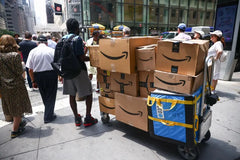
Amazon Prime Day 2025: A Record-Breaking Summer Sales Event
Table of Contents
- Key Highlights:
- Introduction
- The Evolution of Prime Day
- Record-Breaking Sales Figures
- Consumer Behavior and Mobile Shopping Trends
- Competitive Landscape: Retailers Respond to Prime Day
- The Risks of Discount-Driven Sales Promotions
- The Economic Climate and Its Influence on Shopping Behavior
- Key Takeaways and Future Predictions
- FAQ
Key Highlights:
- Amazon's Prime Day 2025 generated $24.1 billion in U.S. online sales, marking a 30.3% increase year-over-year.
- The event spanned four days, with significant sales growth in various categories, including electronics (+95%) and office supplies (+105%).
- Mobile shopping dominated, accounting for over half of all Prime Day sales, significantly influencing consumer purchasing behavior.
Introduction
Amazon's Prime Day has transformed from a mere sales event into a pivotal moment in the retail calendar, now extending into a full-fledged summer shopping season. The 2025 edition, held from July 8 to July 11, has set new benchmarks in online sales, showcasing the evolving nature of consumer behavior and retail strategies. With a record of $24.1 billion in U.S. online sales, this year's event highlights the growing significance of mobile shopping and the fierce competition among retailers. The staggering increase of 30.3% in sales compared to the previous year reflects not just Amazon's market strength but also changing consumer habits driven by strategic discounts and emerging economic factors.
The Evolution of Prime Day
Amazon's Prime Day began in 2015 as a single-day shopping event, a strategy designed to celebrate Amazon's anniversary while boosting sales during the typically slow summer months. Its evolution to a four-day extravaganza in 2025 underscores the growing importance of this event in the retail landscape. By extending the duration, Amazon has managed not only to attract a larger audience but also to create a sense of urgency among consumers, prompting early purchases in anticipation of potential price hikes due to looming tariffs.
Retailers across the spectrum have taken note, launching competing promotions such as Walmart's Deal Days and Target's Circle Week, effectively turning Prime Day into a battleground for consumer attention. As competition heats up, discounts have become deeper and more enticing, with apparel averaging a 24% discount compared to 20% last year, showcasing a trend toward more aggressive pricing strategies.
Record-Breaking Sales Figures
The sales figures from Amazon's Prime Day 2025 are staggering. Initial reports indicated a slow start, with day one sales totaling $7.9 billion—only a 9.9% increase from the previous year. However, as the event progressed, sales surged dramatically, especially on the second day, contributing to the overall figure of $24.1 billion. This is particularly noteworthy when considering that the entire online spending for the summer event equates to the combined total of two Black Fridays, which last year saw $10.8 billion in online sales.
The surge in sales is attributed to several factors, including the strategic timing of discounts aimed at pre-empting price increases due to tariffs. Categories like electronics, home improvement, and office supplies experienced explosive growth, with increases of 95%, 76%, and 105% respectively. This reflects a shift in consumer spending patterns, where shoppers are not just looking for deals but are also motivated by practical needs, such as back-to-school supplies and home office enhancements.
Consumer Behavior and Mobile Shopping Trends
A significant trend emerging from this year’s Prime Day is the dominance of mobile shopping. Reports indicate that mobile transactions accounted for over half of all sales made during the event. This shift towards mobile is reflective of broader consumer behavior trends, where convenience and accessibility have become paramount. As more consumers engage with e-commerce through their smartphones, retailers are adapting by optimizing their platforms for mobile users, enhancing user experience, and streamlining purchase processes.
The implications of this trend extend beyond just sales figures; they indicate a fundamental change in how consumers shop. With mobile shopping on the rise, retailers must now prioritize mobile-friendly websites and applications, ensuring that customers can easily navigate and complete purchases on their devices.
Competitive Landscape: Retailers Respond to Prime Day
The competitive landscape surrounding Prime Day has transformed the event into an arms race among retailers. Companies like Walmart and Target have strategically aligned their promotional events with Prime Day, offering competitive discounts and deals to lure customers away from Amazon. This strategy not only capitalizes on the heightened consumer interest during Prime Day but also helps these retailers capture a larger share of the market.
The competitive pressure has prompted all retailers to enhance their promotional strategies. For instance, discounts across various categories have deepened, with toys seeing an average discount of 19% compared to 15% in the previous year. This aggressive pricing strategy is designed to attract price-sensitive shoppers, particularly during a time when economic uncertainties loom due to inflation and potential tariff increases.
The Risks of Discount-Driven Sales Promotions
While sales promotions are effective in driving traffic and boosting sales, they come with inherent risks for retailers. Deep discounts can lead to thinner margins and reduced profitability. Retailers must carefully balance their promotional strategies to avoid conditioning consumers to wait for sales before making purchases. This cycle can create long-term challenges for businesses, where consumers delay spending in anticipation of future discounts.
The potential impact of such strategies on consumer behavior is significant. If shoppers become accustomed to waiting for sales events, it can lead to a decline in overall sales volume during non-promotional periods, adversely affecting retailers' financial health. As a result, retailers must find ways to create urgency and excitement around their offers without compromising their profit margins.
The Economic Climate and Its Influence on Shopping Behavior
The economic landscape plays a critical role in influencing consumer behavior during major shopping events like Prime Day. With inflationary pressures and potential tariffs looming, consumers are increasingly looking to capitalize on sales opportunities. This year’s Prime Day saw shoppers taking advantage of deep discounts to shop ahead of anticipated price increases, particularly in essential categories.
The economic climate not only affects consumer spending habits but also shapes retailers' promotional strategies. In an environment where consumers are cautious about their spending, offering substantial discounts can be a powerful tool to drive sales while building customer loyalty. However, retailers must also consider the long-term implications of such strategies on their brand perception and overall profitability.
Key Takeaways and Future Predictions
The success of Prime Day 2025 underscores the importance of strategic planning and adaptability in the retail industry. As retailers continue to navigate a competitive landscape marked by shifting consumer preferences and economic uncertainties, the ability to offer compelling promotions while maintaining profitability will be crucial.
Looking ahead, it is anticipated that Prime Day will continue to evolve, potentially extending beyond a single event into a broader summer sales season. As consumer behavior continues to shift towards mobile and online shopping, retailers must adapt their strategies accordingly, focusing on enhancing user experiences and offering personalized promotions to attract and retain customers.
The ongoing evolution of Prime Day reflects a larger trend within the retail sector, where events are no longer confined to traditional shopping seasons. Instead, they are becoming integral components of year-round marketing strategies aimed at driving engagement and sales.
FAQ
What is Prime Day?
Prime Day is an annual sales event hosted by Amazon, offering significant discounts and promotions on a wide range of products. It was launched in 2015 and has since evolved into a major shopping event, attracting millions of consumers.
How did Prime Day 2025 perform compared to previous years?
In 2025, Prime Day generated $24.1 billion in U.S. online sales, representing a 30.3% increase from the previous year. This marks one of the most successful iterations of the event to date.
What categories saw the most significant sales growth during Prime Day?
Notable sales growth was reported in categories such as office supplies (+105%), electronics (+95%), and home improvement (+76%). These categories reflect changing consumer needs and priorities.
Why is mobile shopping important for Prime Day?
Mobile shopping accounted for over half of all Prime Day sales in 2025. This trend highlights the growing reliance on smartphones for online shopping, prompting retailers to optimize their platforms for mobile users.
What are the risks associated with deep discounts during sales events?
While deep discounts can drive sales, they also lead to thinner profit margins and may condition customers to wait for sales rather than making purchases at regular prices, creating long-term challenges for retailers.
How do economic factors influence shopping behavior during Prime Day?
Economic factors such as inflation and potential tariffs can influence consumer behavior, prompting shoppers to seek out discounts and promotions to mitigate rising prices on essential goods.
Potencialize seu ecommerce com nossos insights e atualizações semanais!
Fique alinhado com o que está acontecendo no mundo do comércio
Endereço de E-mail
Escolhido para Você

12 July 2025 / Blog
The Rise of Affiliate Marketing: How Businesses Are Shifting Towards Consumer-Driven Recommendations
Leia Mais



